Aging in place is defined by the U.S. Centers for Disease Control and Prevention (CDC) as “the ability to live in one’s own home and community safely, independently, and comfortably, regardless of age, income, or ability level.”
What is “aging in place”? For whom does this option make the most sense?
Almost 90% of Americans want to age in their own homes. However, the possibility for needing assistance with activities of daily living due to disabilities increases for Americans over age 65, and it’s even more significant for those over age 85.
U.S. adults aged 85 or older are approximately three times as likely to need assistance with activities of daily living as adults aged 75 to 84, and they’re six times as likely to require help as those aged 65 to 74. 20.7% of adults aged 85 or older need help with tasks such as eating, bathing, dressing, or walking, whereas 7% of those aged 75 to 84 and 3.4% of those aged 65 to 74 do.
When seniors have been asked what aging in place meant to them, the results were that older people want choices about where and how they age in place. Aging in place is an advantage in terms of a sense of attachment or connection and feelings of security and familiarity in relation to both homes and communities. Aging in place relates to a sense of identity both through independence and autonomy and through caring relationships and roles in the places people live.
What are the challenges of aging in place? What are the advantages?
The most common barriers for seniors to age in place are the increasing levels of assistance needed to maintain activities of daily living and instrumental activities of daily living, as well as transportation and affordable housing.
Because Americans are living longer, they develop increasing numbers of comorbid disease and, in turn, have increasing numbers of limitations and disabilities which lead to significant higher healthcare consumption.
Per a 2008 Institute of Medicine (IoM) report, “Although older adults make up only about 12% of the U.S. population, they account for approximately 26% of all physician office visits, 47% of all hospital outpatient visits with nurse practitioners, 35% of all hospital stays, 34% of all prescriptions, 38% of all emergency medical service responses, and 90% of all nursing home use.”
The IoM recommends a three-pronged approach to improve the ability of the healthcare workforce to care for older Americans:
- Enhance the competence of all individuals in the delivery of geriatric care
- Increase the recruitment and retention of geriatric specialists and caregivers
- Redesign models of care and broaden provider and patient roles to achieve greater flexibility
A more recent 2021 report by the National Academy of Medicine provided a similar approach, with recommendations that included:
- Create an adequately trained workforce
- Strengthen the role of public health
- Remediate disparities and inequalities
- Develop, evaluate, and implement new approaches to care delivery
- Allocate resources to achieve patient-centered care and outcomes, including palliative and end-of-life care
- Redesign the structure and financing of long-term services and supports
What challenges can veterans, in particular, expect to face? What resources are available for veterans who opt for these options?
It has been shown that elderly veterans are more likely to have a limitation in activities of daily living and an increased level of dependence over time. Over 50% of elderly veterans report difficulty in functioning and rate their health status as fair or poor. Additionally, elderly African American and Hispanic veterans report worse health than non-Hispanic white veterans across most health indicators. It is necessary that programs serving older veterans be adept at the ongoing medical management of chronic disease and the provision of long-term care services.
Veterans who use ambulatory care settings reported lower levels of health status, which reflects more disease than a non-VA civilian population. It has also been found that veterans experience greater age-related changes in health than non-veterans. When examining memory performance and its relationship with military service, it has been shown that later in life, veterans exhibit significantly steeper aging-related declines in immediate recall, particularly among the oldest veterans.
There is still a lot to learn regarding the aging-specific issues for aging female veterans and other subpopulations as they become a larger portion of the military.
What tools, products, or services are recommended for older Americans, especially veterans, looking to age in place?
The Department of Veterans Affairs has a large portfolio of home and community-based services (HCBS) to assist veterans and their caregivers when they have significant issues with meeting their activities of daily living needs.
The Department of Veterans Affairs has implemented multiple initiatives to assist veterans with aging in place, and this includes but is not limited to a multi-year plan for the VA to become the largest integrated health system to implement Institute for Healthcare Improvement age-friendly health systems processes and a multi-year national expansion of home-based primary care, medical foster home, and veteran directed care programs.
The VA is also looking at new models of care to include the “Redefining Elder Care in America Project” pilot underway at two VA healthcare centers. It combines predictive analytics to help identify veterans at high risk for nursing home placement, then we have a care coordinator proactively work with primary care and the veteran to see if they would have an aging in place benefit from adding home and community-based services.
To gain understanding of and access to possibly needed home and community-based services, enrolled veterans or their caregivers should contact their assigned Primary Care Patient Aligned Care Team (PACT) social worker. It is important that the veteran’s primary care team is aware of their needs and work together to gain the needed services.
The VA Geriatrics and Extended Care (GEC) website also provides information, education, and videos to help older American veterans learn about the different geriatric and extended care services they may be eligible for. It also includes information for caregivers, dementia patients, and even advanced care planning, intended to educate and help the veteran start a conversation with their PACT team.



